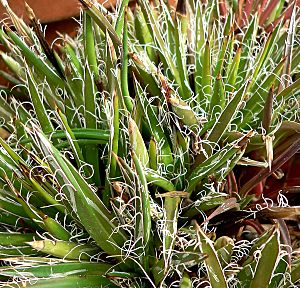Santa Cruz striped agave facts for kids
Quick facts for kids Santa Cruz striped agave |
|
|---|---|
 |
|
| Conservation status | |
| Scientific classification |
Agave parviflora is a type of succulent that lives for many years, also called a perennial. It's a flowering plant in the asparagus family. People often call it the Santa Cruz striped agave, smallflower century plant, or small-flower agave. This plant naturally grows in Arizona in the United States and Sonora in Mexico.
The name parviflora comes from Latin and means "small-flowered," which describes its tiny blooms.
Contents
About the Smallflower Agave
What It Looks Like
This agave is quite small. It forms a round shape called a rosette, which can grow up to 25 centimeters (about 10 inches) tall and 20 centimeters (about 8 inches) wide. Its thick, juicy leaves are a dark, waxy green with cool white patterns. They can be up to 20 centimeters (about 8 inches) long. The edges of the leaves have thin fibers that peel off, making them look unique.
In the summer, the plant sends up a tall stalk, called an inflorescence, which can be 1 to 2 meters (about 3 to 6.5 feet) high. Cream or pale yellow flowers bloom on this stalk. Bees, like bumblebees, help to pollinate these flowers, which means they help the plant make seeds.
Where It Grows and Why It's Special
The Agave parviflora is the smallest agave plant found in Arizona. Because it's so unique and pretty, many plant collectors want to have it. This has caused its numbers to go down in the places where it naturally grows. Today, there are only about two dozen natural groups of these plants left in Arizona.
Other things that can harm this plant include building new roads and mining activities. However, scientists from the IUCN don't think it's in danger of disappearing. This is because its population seems to be steady, and it grows in several areas that are protected.
Valued in Gardens
This plant is also very popular for growing in gardens. It has even won a special award called the Royal Horticultural Society's Award of Garden Merit. This award means it's an excellent plant for gardeners to grow.
There are also different types of this plant, called subspecies. These include ssp. parviflora and ssp. densiflora.
See also
 In Spanish: Agave parviflora para niños
In Spanish: Agave parviflora para niños


